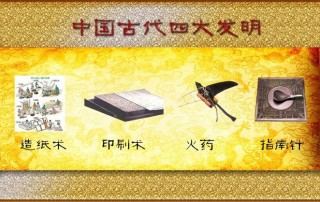Top 5 Chinese inventions
 Top 5 Chinese inventions you never knew came from China
Top 5 Chinese inventions you never knew came from China
It is general knowledge that China is credited with inventing gunpowder, noodles, paper, printing, silk and compass. However, there are many other things people widely use today but never guess these things are, actually, Chinese inventions. Here are the top 5 Chinese inventions you never knew came from China.
发明 – fāmíng – invention
四大发明 – the four great Chinese inventions: paper, printing, magnetic compass and gunpowder.
Fork 叉子chāzi
The earliest example of fork as utensils is from ancient China. Bone forks were found at a burial site of Qijia culture (2400-1900 BC). They were also found in Shang Dynasty (1600-1050 BC) burial sites as well as subsequent dynasties. Chopsticks were invented much later and replaced forks in China as the main utensil where they were viewed to be more efficient. In the Roman Empire, bronze and silver forks were used to cook and serve food. And until much later it was still common practice to eat meat with bare hands. It was then that etiquette made it the norm to use forks instead of fingers to eat meat. The forks were modified to three-pronged or four-pronged, with a slight curve for easier scooping from plates.
Kite 风筝fēngzheng
First kites appeared about 3000 years ago in China and then spread to Korea and, eventually, Europe. European explorer Marco Polo was among the first people to document the construction of kites and how to fly them. The first kites were made from sticks, leaves, silk etc. Initially, kites were used for practical rather than entertainment purposes. The military used kites for lifting observers and spies, targeting, barrage attacks, mail and small package delivery. Kite aerial photography was used as late as 1906 to by George Lawrence to photograph the earthquake devastated city of San Francisco (aircraft were still in the development stage then). They are also used by meteorologists to take weather readings and as sails in some sports.
Fireworks 爆竹 bàozhú
 Legend tells of a Chinese cook who accidentally spilled saltpeter into a cooking fire, producing an interesting flame. Saltpeter, an ingredient in gunpowder (another famous Chinese innovation) , was used as a flavoring salt sometimes. The other gunpowder ingredients, charcoal and sulfur, also were common in early fires. Though the mixture burned nicely with a pretty flame in a fire, it exploded if it was enclosed in a bamboo tube.
Legend tells of a Chinese cook who accidentally spilled saltpeter into a cooking fire, producing an interesting flame. Saltpeter, an ingredient in gunpowder (another famous Chinese innovation) , was used as a flavoring salt sometimes. The other gunpowder ingredients, charcoal and sulfur, also were common in early fires. Though the mixture burned nicely with a pretty flame in a fire, it exploded if it was enclosed in a bamboo tube.
While first gunpowder appeared about 2000 years ago, exploding firecrackers were produced later during the Song dynasty (960-1279) by a Chinese monk named Li Tian, who lived near the city of Liu Yang in Hunan Province. These firecrackers were bamboo shoots filled with gunpowder. They were exploded at the commencement of the New Year to scare away evil spirits.
Toilet paper 卫生纸 wèishēngzhǐ
Those who come to China for the first time might be surprised to find no toilet paper in public restrooms, but they might be more surprised to learn that the toilet paper originates from China. Early Chinese writers made mention of toilet paper in their works as early as 589 AD. Yan Zhitui wrote about it in 589 AD in his works. It is recorded that ten million packages of toilet paper was manufactured annually in the Yuan Dynasty. Each package had about a thousand to ten thousand sheets of toilet paper. Another mass production was recorded during the Ming Dynasty. It is found that there were more than 700,000 sheets were manufactured. It was intended for general use within the imperial court.
Electronic cigarette 电子烟 diànzǐyān
The device marketed as the panacea for nicotine addicts was invented by a Chinese pharmacist Hon Lik, who patented the first nicotine based electronic cigarette in 2003. The principle of an e-cigarette lies in vaporization of a flavored liquid. The liquid inside might contain nicotine, but some of e-cigarettes are nicotine-free. The user inhales the vapor and can gradually cut down on the nicotine substances in the liquid.
Today many of the world’s most cutting edge innovations are happening in Hangzhou, a Chinese Silicon Valley not far from Shanghai. Dozens of domestic and international tech giants have their offices there. You can read more about the Hangzhou city and our internship programs there or check out the whole list of internship positions which Hutong School offers in China. Join one of the internship programs and be the first to know about new Chinese inventions.
